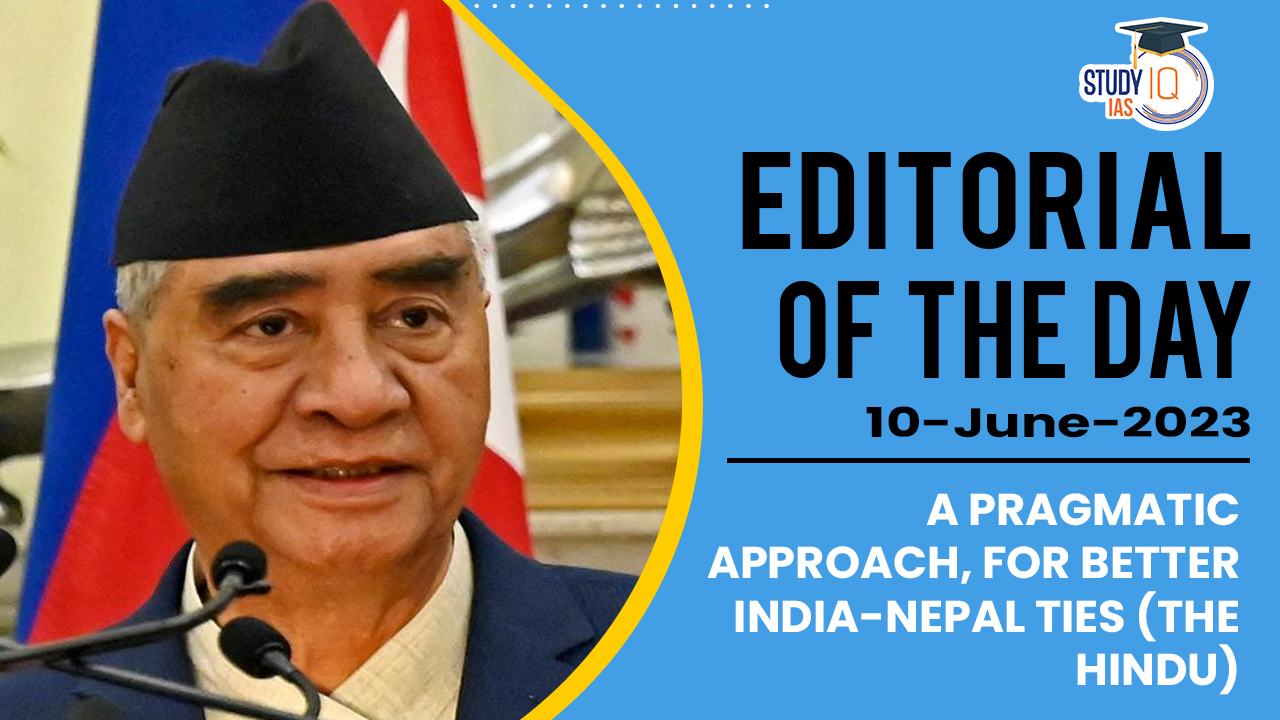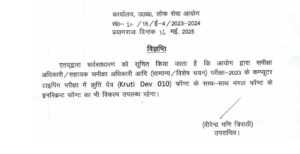Table of Contents
Context: The article is discussing the bilateral relations between Nepal and India, with a focus on the recent visit of the Nepal Prime Minister Pushpa Kamal Dahal Prachanda to India. It highlights the importance of a steady focus on development and a pragmatic approach in strengthening the ties between the two countries. Despite challenges faced by Nepal in terms of democracy, governance, and stability, as well as existing bilateral issues, the article emphasizes that both Nepal and India have demonstrated mutual sensitivity and a willingness to address these challenges, which can contribute to re-energizing their bilateral relations. It highlights various aspects of the bilateral agenda, including politics, economics, trade, energy, security, and developmental cooperation, taking into account the post-COVID-19 world and the opportunities it presents to both the countries..
A pragmatic approach, for better India-Nepal ties background
India-Nepal ties: Significance
Economic significance:
- Trade: Nepal shares a border with 5 Indian states (Uttarakhand, Uttar Pradesh, Bihar, West Bengal and Sikkim). Hence an important point of trade and economic exchange.
- Energy security: India and Nepal share many trans-boundary Himalayan rivers with huge hydropower potential.
- Foreign exchange: Remittances sent from India is one of the major sources of foreign exchange.
- Strategic significance:
- Buffer state: Nepal acts as buffer state between India and China. It prevents any future chances of aggression.
- Internal security: Cooperation of Nepal is necessary for curbing cross-border smuggling of weapons, fake currency and narcotics.
- Cultural significance:
- Pilgrimage sites: Many Hindu and Buddhist religious sites are in Nepal making it an important pilgrimage site for Indian citizens.
- Common religion: Majority of citizens in India and Nepal are Hindus, forming a major civilisational link between the two nations.
- Diaspora: Nepali diaspora in India and Indian workforce in Nepal act as people-to-people link.

Areas of cooperation between India and Nepal
| Trade and Economy |
|
| Connectivity |
|
| Defence cooperation |
|
| Cultural cooperation |
|
| Energy cooperation |
|
| Assistance |
|
| Multilateral Partnership |
|
Major challenges in India Nepal Relations

Decoding the Editorial
The article discusses the growing India-Nepal ties.
- Pragmatic Handling of Hurdles:
- The article acknowledges the Prime Minister of Nepal for his realistic handling of bilateral irritants between Nepal and India.
- Despite being in a weak political position as the leader of the third largest party in Parliament and facing potential challenges from other leaders, Prachanda has shown political courage and pragmatism.
- He has chosen to ignore political noises and instead focused on finding solutions to long-standing issues such as the 1950 Treaty, border differences, and India’s reluctance to receive the report of the Eminent Persons Group (EPG) established by both governments.
- In the past, Prachanda had created tensions with India by taking certain actions, such as visiting China before India and dismissing the Army chief, which India strongly objected to.
- However, in his current term, he has demonstrated a more serious, self-confident, and mature approach as a statesman.
- The Indian Prime Minister also assured Prachanda that differences on the border issue would be resolved to mutual satisfaction.
- Both sides have refrained from asserting their own official versions of the border as the correct one, indicating a willingness to engage in constructive dialogue.
- Economic Integration:
-
- The visit of the Nepal Prime Minister to India has emphasized the importance of economic integration and identified key areas that can significantly transform the economic landscape of the sub-region.
- These “game changers” include hydropower projects to provide energy to India and eventually Bangladesh, infrastructure development, access to Indian river transport, the creation of innovative tourism circuits, and improved connectivity between Nepal and India.
- Given the impact of the COVID-19 pandemic, it was crucial to renew the commitment to bilateral cooperation and enhance the delivery of agreed-upon initiatives.
- The Mahàkali Treaty, which focuses on the Pancheshwar Multipurpose Project (PMP) involving power stations on both banks of the river, received remarkable cross-party consensus and parliamentary ratification in both countries, demonstrating the commitment to infrastructure projects despite political changes.
- In the power sector, there is a new dimension of cooperation with the transmission passage for power transactions from Nepal to Bangladesh through India.
-
-
- With ongoing and planned power projects, along with the finalization of a long-term power trade agreement, the aim is to increase the export of power from Nepal to India to 10,000 MW within a timeframe of 10 years.
- This is expected to bring prosperity to the entire sub-region.
-
- Payment Systems and Technology:
-
- The cooperation between Nepal and India in the areas of payment systems and technology is crucial.
- The Memorandum of Understanding (MoU) between the National Payments Corporation of India and the Nepal Clearing House Ltd. to facilitate cross-border digital payments, along with India’s offer to create a ground station and supply user terminals for the South Asia Satellite to Nepal under grant assistance, are significant developments.
- These initiatives promote regional cooperation in the space sector and enable the application of space technology in various sectors such as telecommunication, broadcasting, tele-medicine, tele-education, e-governance, banking, ATM services, meteorological data transmission, disaster response, and networking among academic and research institutions.
- Challenges:
-
- Nepal faces challenges such as the need to depoliticize cooperation with India in water resources, improve the quality of democracy and governance, and address rampant corruption.
- For India, it is important to address the perception in Nepal that it is no longer a foreign policy priority and ensure that major advancements in sectors like hydropower are credited to various political parties rather than just the current government.
- Continued focus on development, as demonstrated during Prachanda’s visit, will lead to India going the extra mile to meet Nepal’s needs and expectations.
- It is suggested that despite potential political instability in Kathmandu, Nepal can expect India’s support and assistance if development remains a priority.
Beyond the Editorial
A strong tie between India and Nepal can have several positive results for India:
- Strategic and Security Benefits: A strong relationship with Nepal ensures a more secure and stable neighbourhood for India. It can help in countering transnational security threats, such as terrorism, cross-border crime, and illegal trafficking. Close cooperation with Nepal can also contribute to India’s strategic interests in the region.
- Economic Opportunities: Nepal offers potential economic opportunities for India. Enhanced bilateral ties can facilitate increased trade and investment between the two countries. Access to Nepal’s market can benefit Indian businesses, and collaborative projects in areas like infrastructure development, energy, and tourism can create economic growth and employment opportunities for both nations.
- Energy Cooperation: Nepal has significant hydropower potential, and cooperation in the energy sector can provide India with a source of clean and renewable energy. Joint initiatives in hydropower projects can help address India’s energy needs and strengthen energy security.
- Connectivity and Trade Routes: A strong tie with Nepal can contribute to the development of connectivity infrastructure, including road networks, railways, and transit routes. This can enhance regional connectivity and provide India with easier access to other countries in South Asia, opening up new trade routes and economic linkages.
- Cultural and People-to-People Exchanges: India and Nepal share deep historical, cultural, and social ties. Strengthening bilateral relations can promote cultural exchanges, tourism, and people-to-people interactions. This can foster greater understanding, goodwill, and friendship between the people of both countries.
- Regional Influence: A strong partnership with Nepal allows India to exert its influence in the region and be seen as a reliable and responsible neighbour. It enhances India’s standing in South Asia and provides opportunities to shape regional initiatives and cooperation.


 UPPSC RO ARO Exam Date 2025 Out: Typing ...
UPPSC RO ARO Exam Date 2025 Out: Typing ...
 Maharashtra Bill to Curb Urban Naxalism,...
Maharashtra Bill to Curb Urban Naxalism,...
 International Maize and Wheat Improvemen...
International Maize and Wheat Improvemen...





















